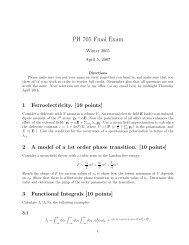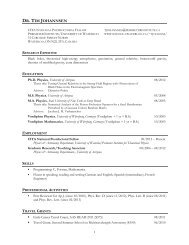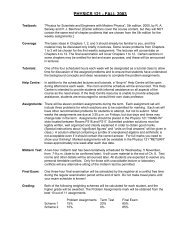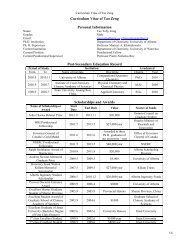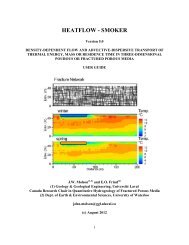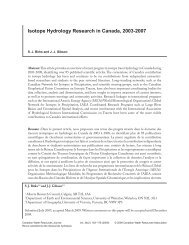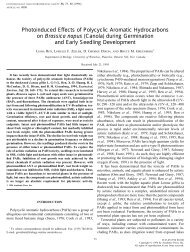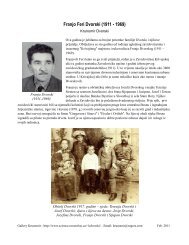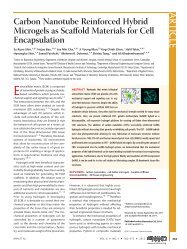POLYMIN - University of Waterloo
POLYMIN - University of Waterloo
POLYMIN - University of Waterloo
Create successful ePaper yourself
Turn your PDF publications into a flip-book with our unique Google optimized e-Paper software.
<strong>POLYMIN</strong> 2005<br />
model involves three separate constituents; the masses <strong>of</strong> aqueous species and complexes,<br />
equilibrium constants which relate these complexes in solution, and the individual ion-activity<br />
coefficients for each species. These constituents are related through a system <strong>of</strong> algebraic<br />
equations that solve for the individual ion activities in a solution, which are in turn used to<br />
predict chemical reaction equilibrium.<br />
Chemical Speciation, Acid-Base Reactions and Redox Reactions<br />
In a solution, there exists a set <strong>of</strong> chemical components and species. The set <strong>of</strong> chemical<br />
components is the minimum number <strong>of</strong> species that uniquely describe a solution and that is<br />
required to be reaction invariant (Mangold and Tsang, 1991). The component mass remains<br />
constant, regardless <strong>of</strong> the distribution between chemical species in both the aqueous and solid<br />
phases. This mass conservation principle yields a set <strong>of</strong> linear algebraic equations, with one<br />
equation for each component (Cederberg, 1985).<br />
The total component concentration T k (moles/1000g H 2 O) is the sum <strong>of</strong> the aqueous-phase<br />
concentration C k and the solid-phase concentration S k , <strong>of</strong> component k:<br />
T k = Ck<br />
+ S k<br />
(7)<br />
where<br />
C<br />
S<br />
k<br />
k<br />
naq<br />
alk<br />
∑ cl<br />
(8)<br />
l=1<br />
= k = 1, ... N<br />
=<br />
naq<br />
blk<br />
∑ s<br />
k = 1,...<br />
l<br />
N<br />
(9)<br />
l=1<br />
and where c l is the concentration <strong>of</strong> species l in the aqueous phase (moles/1000g H 2 0), s l is the<br />
concentration <strong>of</strong> species l in the solid phase (moles/1000g H 2 O), a lk is the stoichiometric<br />
coefficient <strong>of</strong> component k in species c l , b lk is the stoichiometric coefficient <strong>of</strong> component k in<br />
species s l , n aq is the number <strong>of</strong> species in the aqueous phase, and n s is the number <strong>of</strong> species in<br />
the solid phase.<br />
The total mass <strong>of</strong> each chemical component must be known to describe a solution. The<br />
distribution <strong>of</strong> the species included in the component concentrations is estimated by mass-action<br />
equations that form a set <strong>of</strong> nonlinear algebraic equations, with one equation for each chemical<br />
species. For the aqueous-phase species, these equations are:<br />
N c<br />
alk<br />
χ = K ∏ χ<br />
naq<br />
(10)<br />
l<br />
cl<br />
k=1<br />
k<br />
while for the solid-phase species, they are:<br />
l = 1,...<br />
11




